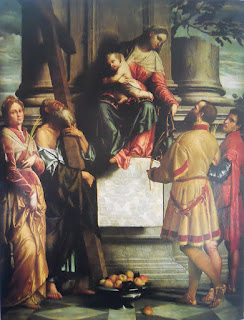Bergamo artist left treasure trove of pictures to remember him by
Enea
Salmeggia, who was active during the late Renaissance period and left behind a
rich legacy of paintings in Lombardy, died on 25 February 1626 in Bergamo.
Enea Salmeggia's Il Martirio di Sant'Alessandro
hangs behind the altar of Sant'Alessandro in Colonna
Salmeggia,
also known as Il Talpino, or Salmezza, spent time in Rome as a young man, where
he studied the works of Raphael. His style has often been likened to that of Raphael
and he has even been dubbed the ‘Bergamo Raphael’ by some art enthusiasts. A
drawing in the Ashmolean Museum in Oxford, of two figures seated along with some
architectural studies, was previously attributed to Raphael, but has now been
ascribed to Enea Salmeggia.
The artist
was born at Salmezza, a frazione of Nembro, a comune in the province of
Bergamo, between 1565 and 1570. It is known that Salmeggia grew up in Borgo San
Leonardo in Bergamo, where his father, Antonio, was a tailor.
He learnt
the art of painting from other Bergamo painters and is also believed to have
studied under the Bergamo artist Simone Peterzano in Milan. Caravaggio was one
of Peterzano’s most famous pupils and it has been suggested that Salmeggia
could have been studying with Peterzano at about the same time as Caravaggio.
Salmeggia was
so young when he received his first commission to paint an Adoration of the
Magi for the Basilica of Santa Maria Maggiore in Bergamo that his father had to
sign the acceptance document on his behalf.
Salmeggia's Portrait of a Gentleman
can be seen at Accademia Carrara
The artist married
Vittoria Daverio, the sister of Milanese sculptor Pietro Antonio Daverio, and
they had six children. Two of their children died from the plague and one went
into a monastery, but his daughters, Chiara and Elisabetta, and his son,
Francesco, helped in his workshop near the Church of Sant’Alessandro in Colonna
in Via Sant’Alessandro, and they later became painters themselves.
One of Salmeggia’s
most famous works, Il Martirio di Sant’Alessandro, an oil on canvas, completed in
1623, can still be seen behind the altar in the Church of Sant’Alessandro in
Colonna.
The Church
has a Roman column in front of it, which is believed to mark the exact spot
where Bergamo’s patron saint, Sant’Alessandro was martyred by the Romans in 303
for refusing to renounce his Christian faith. Every year, on 26 August, the
Festa di Sant’Alessandro, Bergamo people commemorates Sant’Alessandro’s
decapitation there.
After Salmeggia died in Bergamo in 1626 he was buried in the Church of Sant’Alessandro in Colonna.
There are paintings by Salmeggia in the churches of Sant’Andrea and Santi Bartolomeo e Stefano in Bergamo and the Accademia Carrara, a prestigious art gallery in Bergamo, also has works by Salmeggia, including his Portrait of a Gentleman. Further afield, there are paintings by Salmeggia in Brescia, Lodi and Milan.
In Nembro, the suburb where Salmeggia was born, the Church of San Martino has no fewer than 27 of his paintings for visitors to admire.

